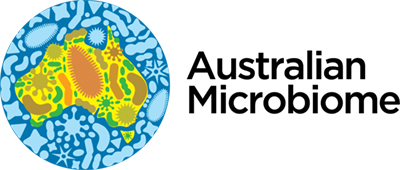Initiative core activities
Microbial diversity survey (amplicons)
Summary – Microbial communities in natural environments are vital to ecosystem and planetary functions. Despite great advances over the past decade, there are still large gaps in our knowledge of their diversity and ecology. The Australian Microbiome Initiative is generating a database of microbial diversity with associated contextual metadata across extensive environmental gradients at continental scale.
Each natural environment is surveyed on a set of bacterial and archaeal 16S, eukaryotic 18S and fungi ITS.
Data products are provided through an open access data portal in both raw sequence (FASTQ) and analysed zero-radius operational taxonomic units (ZOTUs, Edgar 2017) table formats, along with the contextual metadata. The data portal provides a user-friendly search tool to quickly identify samples of interest.

Keywords: amplicon, microbial communities diversity, 16S, 18S, ITS, archaea, bacteria, eukaryotes, fungi, microbes, soil, sediments, seawater, terrestrial, marine, host associated
Temporal microbial diversity (amplicons)
Summary – Microbial communities can be strongly affected by the seasonal variation of environmental parameters. The ongoing surveys of the changes in microbial communities throughout the year, allows for the correlation to significant contextual parameters.
Long term observatories are permitting the creation of fitted hindcasting models that can be proofed through real measured data, and further edited to build predictive models to be run through potential scenarios of environmental parameters alteration.
This can provide useful information and assist with management as well as conservation efforts.
The Australian Microbiome Initiative has been involved in the ongoing programme monitoring microbial assemblages through monthly sampling at the 7 IMOS National Reference Stations. Further discussions are being held on the possibilities to establish long term observatories in a terrestrial context and at coastal reference stations.

Keywords: time series, monitoring, amplicon, microbial communities diversity, 16S, 18S, ITS, archaea, bacteria, eukaryotes, fungi, microbes, soil, sediments, seawater, terrestrial, marine, host associated
Microbial genomic diversity (metagenomic)
Summary – Microbial diversity based on genetic markers, such as Bacterial 16S, assist in providing the structure of the microbial communities, however, all microbes even from the same genus and species can adapt to specific environments and carry out varying ecosystem services. Often in survey analyses, function or capacity of detected microbes are inferred by previous knowledge on type organisms.
Metagenomics, or the sequencing of the full genetic material of a microbial community extracted from an environmental sample, allows for the study of the potential capabilities of the microbial communities by reconstruction of the gene pools present. Further in depth analyses of these genomic capacities in and between environments is helping to understand the roles microbial assemblages carry out that underpins global biogeochemical cycles and the ecosystem services provided by microbes. Environmental metagenomic also allows reconstruction of environmental genomes of microbes that may not be culturable, thus expanding our global knowledge of microbial potential.
The Australian Microbiome Initiative has previously analysed the metagenomes of microbial assemblages in soil, seawater, sediments, and associated to host organisms such as kelp, seagrass, seaweed and sponge.

Keywords: metagenomics, shotgun DNA sequencing, deep sequencing
Microbial functional diversity (metatranscriptomic)
Summary – While metagenomics allows for the reconstruction of the genetic potential of microbial communities in an environment, the expression of these genes and therefore the microbial activities associated with them can be influenced by environmental conditions. The analysis of the whole environmental transcriptome allows for the view of the expressed genes which are relevant in the conditions at the time of sampling, which is a subset of the metagenomic blueprint. This is particularly relevant in environment which are stable in terms of bacterial communities composition but highly variable and sensitive to environmental conditions, such as sediments or host associated microbes.
The Australian Microbiome Initiative (through Marine Microbes) has previously studied the metatranscriptomes of microbial assemblages in sediments, and associated to host organisms such as kelp, seagrass and sponge.
Keywords: metatranscriptomics, RNA, function
Analytics tools for end user needs (bioinformatics)
Summary – The Australian Microbiome Initiative is producing genomics datasets that are open and publicly accessible through the Bioplatforms data portal. We endeavour to align to the FAIR data principles (making data and data-related tools/services more Findable, Accessible, Interoperable and Reusable). The portal allows users to retrieve “raw” sequences for all data types (amplicon, metagenome, metatranscriptome) as well as analysed zero-radius operational taxonomic units for the genetic markers.
One of the aims of the initiative is to provide usable output for a broad range of users from researchers with high bioinformatic skills to novice practitioners. This involves enhancing the handling of large datasets and developing platforms interface for analytical services through continual improvements as well as developments of analytics and tools for visualisations that fulfils the requirements of end users whichever their level of needs. As an example of this aim, the Bioscience RDC project (2018) funded through Bioplatforms Australia and ANDS/Nectar/RDS via the Research Data Cloud program created systems and methods to connect the Bioplatforms data portal for Australian Microbiome to an established cloud-based national bioinformatics service.

Keywords: genomic data analytics, visualisation tools, bioinformatics, FAIR, open data, publicly accessible
